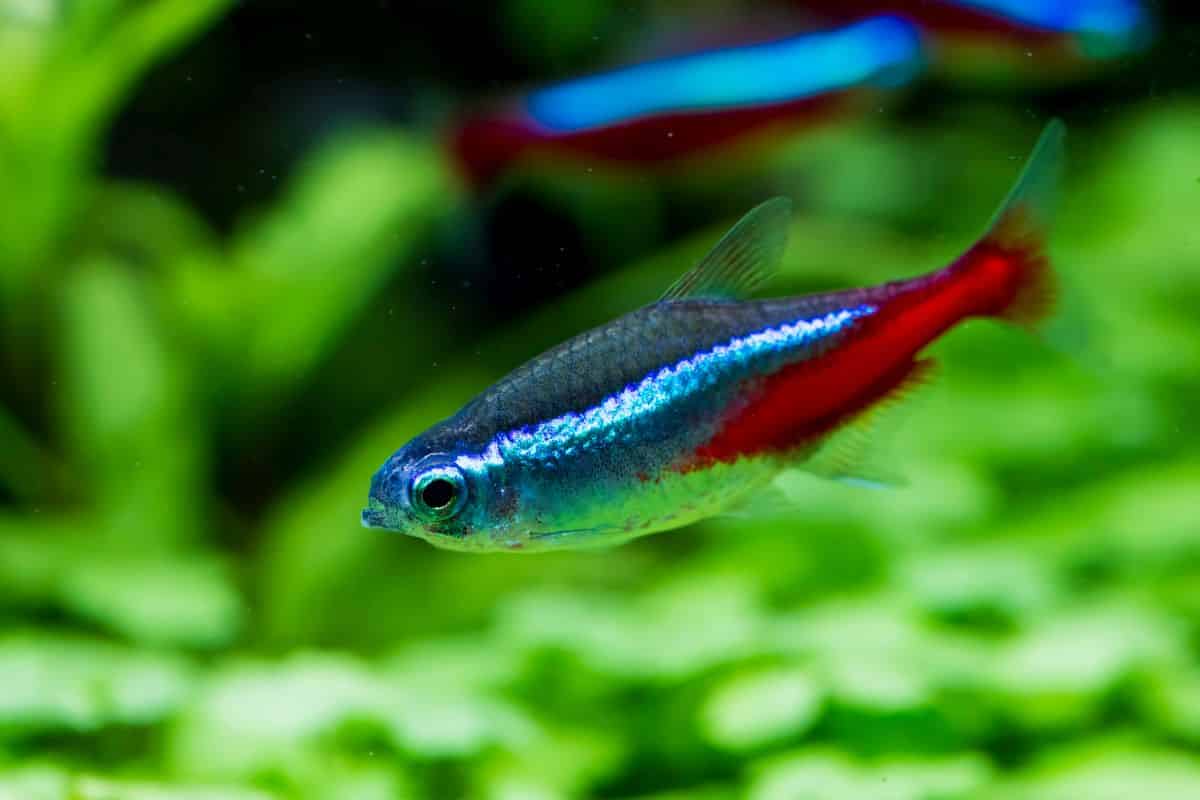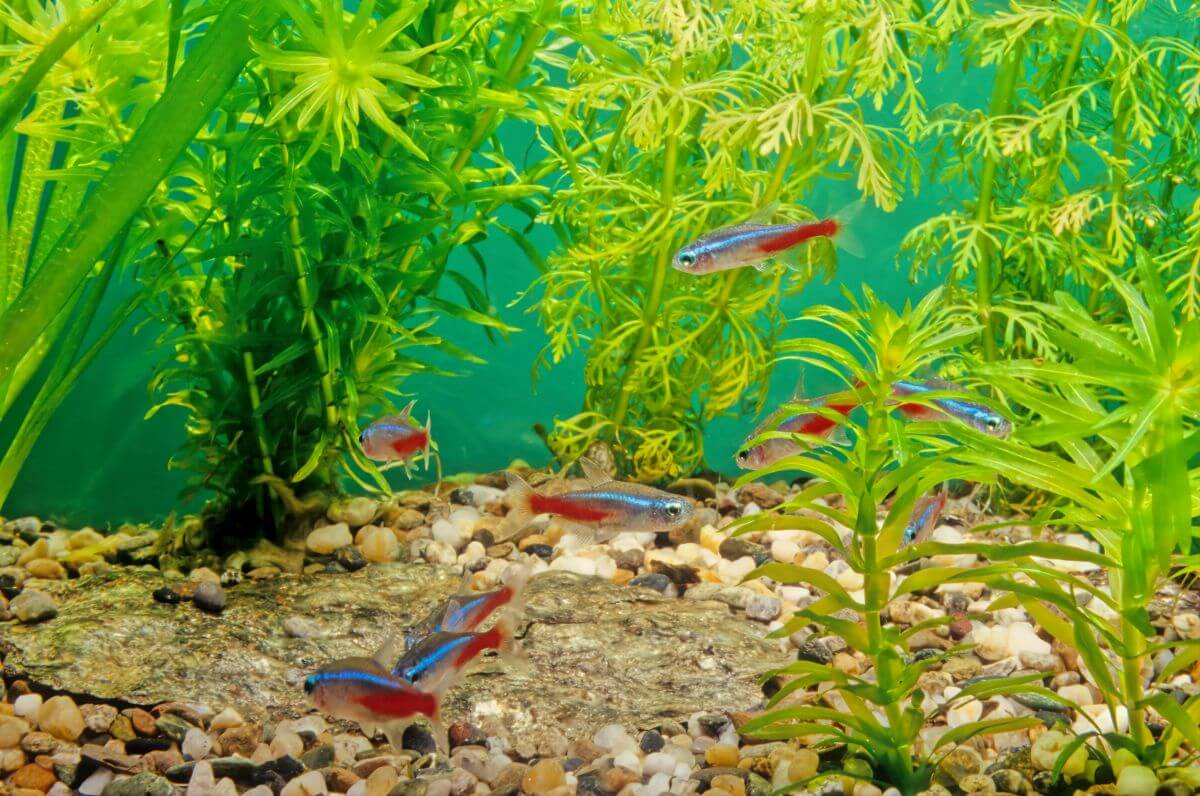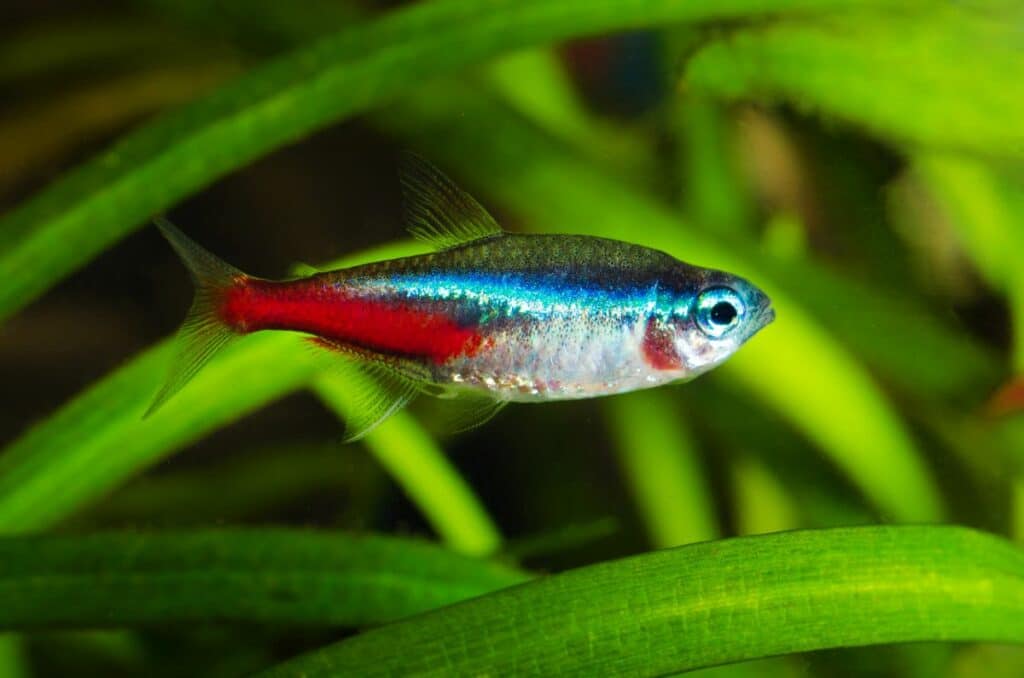the essentials in brief
Neon fish have an average lifespan of around two to five years. You can find information about the character of neon fish here...
In order to enable species-appropriate social behavior, you should keep at least ten neon tetras in a school.
Neon fish should be kept in a well-planted tank with soft water and a temperature of 22-26 degrees Celsius. You can read more about posture here...
neon fish (Paracheirodon innesi) are fascinating and colorful inhabitants of freshwater aquariums. With their bright colors and distinctive features, they not only attract the attention of aquarists, but also impress with their interesting behavior and social interactions. Proper husbandry and care of these small schooling fish requires careful balancing of the environment, water quality, diet and social environment so that they can lead healthy and fulfilling lives in the underwater world.
In this article you will get information about the appearance, character and attitude of neon tetras.
The appearance of neon fish

Neon tetras (Paracheirodon innesi) are small, showy freshwater fish known for their lively and impressive appearance. These popular aquarium inhabitants are characterized by a lively Combination of bright colors and striking body features .
Their physique is lean and laterally compressed, allowing them to move effortlessly through the water. Adult tetras are usually about 3 to 4 centimeters long, which makes them ideal inhabitants of smaller aquariums.
The distinctive coloring of neon tetras is undoubtedly their most distinctive feature. The upper half of the body is of a lglowing, radiant blue criss-crossed with a metallic shimmer in places. There is a light horizontal line running down the sides of the fish, starting near the head and extending to the caudal fin. This line varies from a bright, luminous blue through a strong turquoise to a rich green, depending on how well the fish are cared for and fed.
Note: This distinctive line gives neon tetras their name and distinguishes them from other fish species.
Neon fish have fins transparent and form an attractive contrast to the glowing body coloring. Anal and dorsal fins are slightly rounded, while the caudal fin often has a delicate fork. The fins can also feature touches of color, adding to the overall appeal of these fish.
All in all, the appearance of neon tetras is a feast for the eyes and one of the reasons they are so popular with aquarists. Their bright colors and eye-catching features add a vibrant and appealing atmosphere to any aquarium. However, it's important to know that optimal housing conditions and water quality are essential for these beautiful fish to retain their impressive coloration and health.
The character
Neon tetras (Paracheirodon innesi) are not only known for their eye-catching coloring, but also for their interesting behavior and personality traits that make them fascinating aquarium inhabitants.
The small fish are mostly peaceful and sociable. They do best when kept in groups of at least ten or more animals, as this is in line with their natural gregarious behavior. In a well-planted aquarium, neon tetras often form a harmonious community, swimming closely together and exhibiting impressive synchronized swimming behavior.
One notable behavior of neon tetras is their brisk activity during dusk and dawn. Then they are particularly active, swim faster and play in the water. During the day they usually prefer quieter areas of the aquarium.
Despite their sociable nature, tetras can sometimes be shy especially when they are in an unfamiliar environment or when new roommates arrive. It is important to give them enough places to hide and retreat to make them feel safe.
Neon fish are usually peaceful neighbors and can coexist well with other small and gentle fish species. However, aggressive or larger fish species should be avoided to minimize conflict and stress.
Additional information: Another interesting behavior of neon tetras is their ability to display colors and moods. When excited or courting, the bright colors on the sides of their bodies can glow more intensely. However, when they are stressed or uncomfortable, their colors may fade temporarily.

The right attitude
Proper care of neon tetras requires careful consideration of their environment, water parameters, diet, and social needs to ensure them a healthy and fulfilling life.
- Aquarium size and environment: Since neon tetras are schooling fish, it is important to keep them in a large enough group of at least ten animals. An aquarium with a length of 60 cm or more is recommended. The aquarium should be well planted to provide hiding places and protection. The substrate can consist of fine gravel or sand.
- Water quality and parameters: Neon fish prefer soft, slightly acidic water. The pH value should be between 6,0 and 7,5, the water hardness between 2 and 10 dH. Regular water maintenance with a water change of about 20-30% per week is essential to maintain optimal conditions.
- Water temperature: The ideal temperature for tetras is between 22 and 26 degrees Celsius. Water that is too cold or too warm can lead to stress and illness.
- Lighting: Subdued lighting with shady plants simulates the neon fish's natural environment and brings out their rich colors.
- Food: Neon fish are omnivores. They should be fed a variety of dry food, frozen food and live food such as small insect larvae, microorganisms and artemia to ensure a balanced diet.
- Social behaviour: Due to their swarming behavior, neon tetras should be kept in a sufficiently large group. A small swarm can lead to stress and behavioral problems. They can be socialized well with other peaceful fish species of a similar size, but should be protected from aggressive or larger species.
- Behavior and environment: Neon tetras are most active at dusk and early morning. Provide them with enough hiding spots and plants to make them feel safe. Monitor their behavior regularly for signs of stress, illness, or behavioral changes.
- Water change and care: Regular water changes, removal of excess food and cleaning of the substrate are necessary to keep the water quality optimal.
Tip: Ask an expert if you are unsure about posture.
Pretty and adorable fish
With their bright colors, harmonious shoal behavior and interesting personality, neon tetras are fascinating aquarium inhabitants. Proper care and husbandry, ranging from the right environment and water quality to a varied diet, are crucial to enabling them to lead healthy and fulfilling lives.
If we respect their natural needs and pay attention to their behavior, we can create a vibrant and fascinating underwater world where neon tetras shine in all their glory.


